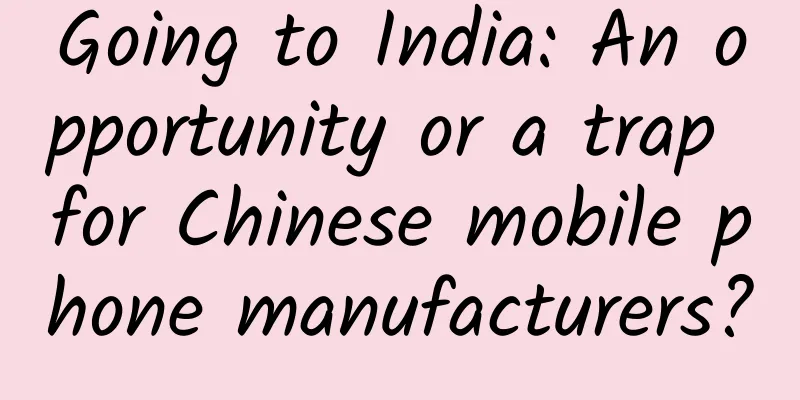Going to India: An opportunity or a trap for Chinese mobile phone manufacturers?

|
With the words "Are You Ok" from Lei Jun, CEO of Xiaomi, the Indian mobile phone market has once again captured the imagination of Chinese mobile phone manufacturers. As the world's third largest mobile phone market, with a relatively low market entry threshold and user demand similar to that of the Chinese mobile phone market, Chinese mobile phone manufacturers have taken India as their first step towards overseas markets and a new gold mine. Is the truth really as simple as it seems? Is the Indian market an opportunity or a trap for Chinese mobile phone companies? Here we might as well take a look at why our manufacturers want to enter the Indian market. There have been many media and related comments on this, so I will not repeat them. What we want to say is that the most fundamental reason why one of the Chinese mobile phone manufacturers is entering the Indian market is that our business model of winning by volume, on which we rely for survival and development, has encountered a bottleneck. A further explanation is that our so-called "cost-effective volume" strategy has reached a critical point. Of course, this critical point will vary depending on the strength of the manufacturer. What critical point? For some manufacturers, the critical point of profit or loss or even more loss. Of course, we do not deny the feasibility of the "cost-effective and high-volume" model (commonly known as small profits but quick turnover) and its applicability to Chinese mobile phone companies at this stage. However, judging from the current situation of the Chinese mobile phone market, we doubt whether Chinese mobile phone manufacturers have achieved the scale of "small profits but quick turnover". First, according to the latest statistics from HIS Technology, in the first quarter of this year, among Chinese manufacturers, except Xiaomi and Huawei, the market share of other manufacturers was in the single digit, showing a high degree of fragmentation or long tail characteristics. This means that most Chinese mobile phone manufacturers have not met the scale requirements of "small profits but quick turnover". Even Xiaomi and Huawei, although their market share has reached double digits, their shipments are mainly low-end and mid-range mobile phones. For example, the reason why Xiaomi ranked first in China's smartphones in the first quarter was mainly due to the shipment of its Redmi series mobile phones below 1,000 yuan. Secondly, according to a previous TrendForce research report, global smartphone shipments in the first quarter of 2015 were 291 million units, a year-on-year decrease of 9.2%. This was mainly due to the weak domestic demand in the Chinese mobile phone market. The space for related manufacturers in the Chinese smartphone market to increase sales is shrinking. For Chinese manufacturers, if they want to continue to maintain volume growth, they have to further lower the prices of mobile phones. However, as mentioned earlier, the long tail of the market share of Chinese mobile phone manufacturers, coupled with the fact that most manufacturers have reached or exceeded the critical point, will face the risk of losses or increased losses if they want to seek further breakthroughs in terms of volume. In fact, when this critical point came, not to mention the second- and third-tier domestic mobile phone manufacturers, even the "China Cool Alliance" that was once known for its strength, two of them have already failed, namely Lenovo and ZTE (which are no longer in the top 5). It can be seen that the "volume-oriented" model of Chinese mobile phone manufacturers has hit bottom. Therefore, manufacturers with a little strength are moving towards overseas markets (such as India) both proactively and helplessly. After understanding the competition and growth methods of the above-mentioned Chinese mobile phone manufacturers in the Chinese market, it is relatively simple to analyze and judge whether the recent entry of domestic mobile phone manufacturers into the Indian market is an opportunity or a trap. In other words, where is the critical point for Chinese manufacturers in the Indian market? What are the factors that affect the change of this critical point? When it comes to the "critical point" of the Indian mobile phone market, we might as well take a specific mobile phone as an example to explain it more intuitively. As the largest local mobile phone brand in India, Micromax recently released a mobile phone, Yureka, which is equipped with a Qualcomm Snapdragon615 chip, 2G memory, 16G storage, a 5-megapixel front camera and a 13-megapixel rear camera. It is basically the same as Xiaomi 4I, except for the screen. Yureka has a 720P 5.5-inch screen, while Xiaomi 4I has a 1080P 5-inch screen. However, Yureka only costs about 882 yuan, while Xiaomi 4I costs 1,272 yuan. The price of Huawei Honor 6plus in India is as high as 2,649 yuan. This shows that Micromax's "critical point" in the Chinese market is much lower than that of Chinese mobile phone manufacturers that have created and can bear it before. But as mentioned before, these Chinese mobile phone manufacturers have already exceeded the "critical point" in the Chinese market where they can bear and drive market growth, which is one of the reasons why they hope to expand into the Indian mobile phone market. Unfortunately, the "critical point" of the Indian mobile phone market is even lower than that of the Chinese market, which means that Chinese manufacturers entering the Indian market must either significantly reduce the prices of their existing mobile phone products, or develop lower-priced smartphones separately to allow themselves to re-enter the "critical point" of the Indian market, before they can grow in volume and compete with Indian manufacturers. But no matter which method is used, it is a severe challenge for Chinese mobile phone manufacturers that have reached or exceeded the "critical point" and entered a new "critical point" again, that is, further pressure on revenue and profits. In fact, it is not only about revenue and profit. Even if our manufacturers enter the "critical point" of the Indian market, the competition is far more intense than that in the Chinese market. According to the latest statistics from market research agency Counterpoint Research, in the first quarter of 2015, Samsung ranked first in the Indian mobile phone market with a market share of 27.8%, followed by Indian local manufacturer Micromax with a market share of 15.3%. The third and fourth manufacturers are also Indian local manufacturers Intex and Lava, with market shares of 9.4% and 5.4% respectively. Among Chinese mobile phone manufacturers, only Lenovo entered the top 5 with a market share of 5.2%. It should be noted that the reason why Lenovo's market share in the Indian market has risen so fast is mainly due to the previous acquisition of Motorola Mobility. If Motorola Mobility is excluded, the market share of Lenovo's own brand mobile phones alone is less than 1%. It can be seen from this that Chinese mobile phone manufacturers, who started from scratch, not only face competition from their old rival Samsung in the Indian market, but also sniping from Indian local manufacturers. Starting from scratch means that in the Indian market, Chinese mobile phone manufacturers have to reinvest in brand, channels, marketing and other aspects. This will add additional pressure to Chinese companies that have already broken the "critical point" and cannot find a "critical point" that meets the new Indian market. Some people may say, what is Samsung? Didn't Chinese mobile phone manufacturers dethrone it from its former number one position in the Chinese market? Yes, but the price we paid is that the former "China Cool Alliance" has disintegrated. At least three of them have been squeezed out of the top 5 in terms of shipments, not to mention revenue and profit. The market share of Chinese manufacturers is highly fragmented, and most manufacturers have entered the "critical point" of the market too early. The arrival of the new "critical point" will make it more difficult for many domestic mobile phone companies to obtain revenue and profits. Inferring the Indian mobile phone market, not to mention that the "critical point" is lower than our current Chinese market, the current market share and non-localization disadvantages alone are enough for Chinese companies entering the Indian market to pay a heavy price. Of course, some people think that the Indian market has huge potential and Chinese mobile phones have the advantage of "cost-effectiveness". On the surface, this is true. The current sales volume of the Indian smartphone market is still growing at a double-digit rate, but the average salary in India is only US$295 per month (equivalent to RMB 1,620). This determines that most Indian mobile phone users think that US$100 is the most appropriate price, and some are only willing to pay US$20 to US$30 (equivalent to RMB 125 to RMB 187) to buy a mobile phone. In the actual market, most smartphones sold in India are priced at 6,700 rupees (equivalent to RMB 688). It is not difficult to see that this so-called huge market is only of practical value to Chinese mobile phone manufacturers at a "critical point" lower than the "critical point" of the Chinese market. Similarly, the so-called "cost-effectiveness" is only meaningful to the market and users at the same "critical point". In summary, we believe that because the "critical point" of the Indian market for Chinese mobile phone companies is lower than that of the Chinese market, the original intention of Chinese mobile phone manufacturers to enter India may be contrary to the actual result (that is, from an overwhelmed "critical point" to a lower "critical point" this year), and they may pay a higher price (revenue and profit). Importantly, the lower "critical point" of the Indian market determines that this mobile phone market cannot be a market driven by innovation and value, and it is of no benefit to stimulate and enhance the innovation capabilities of Chinese mobile phone companies. From this point of view, the probability that the Indian market is a trap for Chinese mobile phone manufacturers is far greater than an opportunity. As a winner of Toutiao's Qingyun Plan and Baijiahao's Bai+ Plan, the 2019 Baidu Digital Author of the Year, the Baijiahao's Most Popular Author in the Technology Field, the 2019 Sogou Technology and Culture Author, and the 2021 Baijiahao Quarterly Influential Creator, he has won many awards, including the 2013 Sohu Best Industry Media Person, the 2015 China New Media Entrepreneurship Competition Beijing Third Place, the 2015 Guangmang Experience Award, the 2015 China New Media Entrepreneurship Competition Finals Third Place, and the 2018 Baidu Dynamic Annual Powerful Celebrity. |
<<: How to make a mobile phone that will satisfy Ren Zhiqiang?
>>: Why are more and more mobile phones giving up memory card slots?
Recommend
2023: Relive the amazing moments of "the great power's heavy weapon"
C919 "spreads its wings", giant ships g...
Are chips really that important? What are the chances of Xiaomi winning by betting big on Pinecone chips?
Although the chip is small and seems to have no t...
Is it possible to replace the person in charge of the WeChat Pay merchant platform? How to change mobile phone number?
There are still quite a lot of WeChat merchants w...
Cell Breakthrough: This newly developed diet produces immediate results in 3 weeks!
Compiled by: Gong Zixin Industrial diet High in p...
For the first time in more than 50 years! The US spacecraft Odysseus successfully landed on the moon
This image provided by Intuitive Machines shows i...
Will driverless cars replace taxis?
Ride-hailing app Uber announced yesterday that it...
I can't get up for work and wake up too early on vacation. Why is this happening?
Not being able to get up for work and waking up t...
Tik Tok and Kuaishou authentication methods and steps!
Before entering today's course, let me share ...
One-click information capture, is the high-dimensional light field detector so powerful?
Produced by: Science Popularization China Author:...
How to create a personal account on Douyin
If a personal Douyin account is successfully crea...
Faster than Hong Kong! LeEco Super 3 X55 Pro full universe video first test
On the afternoon of September 24, LeTV officially...
Alipay vs. WeChat: Lessons for Operations
Following the Circles, Alipay has made another bi...
3 Thinking Habits for Operations: Process Thinking
Whether you are doing activities, user operations...
How do To B companies do marketing promotion?
Before answering this question, there is actually...
Baidu announces pure vision L4 autonomous driving solution "Apollo Lite"
At CVPR (the world's top academic conference ...









